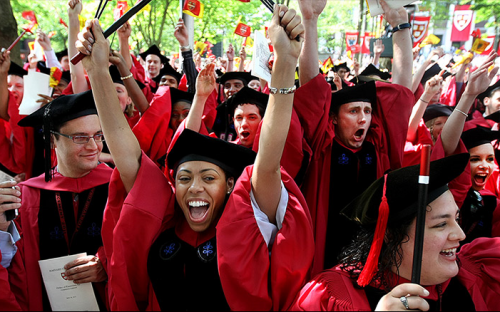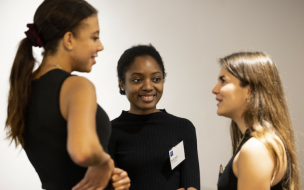After decades of gender inequality, the breeding ground for the world’s future chief executive officers suddenly got serious about championing the role of women in business.
Graced by the likes of Geoffrey Garrett, Wharton School’s dean, and Columbia Business School’s boss Glenn Hubbard, the 40 pledged with US president Barack Obama to increase opportunities for women.
Sunil Kumar, dean of University of Chicago’s Booth School of Business, admits that the pace of change so far has been glacial. “The workplace of tomorrow is changing, slowly,” Sunil says.
Like many of its competitors, Chicago Booth has ramped up its efforts to target top female talent. Women-specific scholarships, a Women Connect conference, and a glitzy advertising campaign are among them. It has paid dividends — 42% of its MBAs now are women. Sunil says: “Having stronger and larger pools of women in our class is a priority.”
Chicago Booth’s move to put itself at the forefront of a global diversity drive echoes a wider move among elite US business schools. It suggests that schools see themselves as a potential aid in the fight to place more women into the top ranks of business.
Anna Beninger, director at Catalyst, the leading US advocacy group for women in business, says a greater focus on diversity at the university level “is critical” to closing the gaping gender divide.
“There is a tremendous opportunity for business schools to educate people about the current reality and what future leaders can do to tear down these barriers,” says Anna, previously a lecturer and researcher at Harvard Business School and NYU.
The data paint a bleak picture. There are only 20, or 4%, women CEOs of S&P 500 companies. Just 5, or 5%, of FTSE 100 CEOs are female.
Judy Olian, dean of UCLA Anderson School of Management, says: “There’s a huge way to go. And what we view business school as being is a springboard. We get women at the starting line, for upward mobility.”
Half of female Fortune 500 CEOs have MBAs — among them Stanford GSB alumnus Mary Barra, CEO of General Motors, and Cornell Johnson graduate Irene Rosenfeld, CEO of Mondelēz.
Until now, few business schools had gender parity in their flagship MBA programs. But a growing number are on the cusp of achieving it, says Elissa Sangster, executive director of the Forté Foundation, a consortium of schools and corporations seeking to advance women’s business careers.
“In 2011, less than a third of MBA students were women. Today, we’re inching closer to 40% in the US and working to close the gap significantly in another five years,” Elissa says. MIT Sloan, UC Berkeley-Haas, and the Kellogg School are among 12 with 40% or greater women’s enrolment.
Elsa Sze began her MBA at Harvard Business School in 2012 after stints at McKinsey & Company, the IMF, Goldman Sachs, JPMorgan Chase, and UBS.
“I wanted to get a capstone experience,” Elsa says. She views the MBA as a stepping stone to higher management positions and a way of closing the gender gap in the higher ranks of business. “There just aren’t enough women,” she says.
Despite recent progress, the share of women enrolled in MBA programs hasn’t edged above 37% over the past decade, according to industry body AACSB. Should business schools be doing more to diversify?
“Many schools do a lot of things. But we need to figure out what the right things are that attract women — the things that move the needle,” says Idalene Kesner, dean of the Kelley School of Business at Indiana University.
Kelley School, which has 30% female enrolment, has run specialized recruiting events targeting women, as well as webinars, and campus preview days. But financial aid has been one of the biggest big lures, Idalene says.
In 2015, 36 MBA programs partnered with the Forté Foundation dished out $18.5 million in scholarships to women, up from $5.6 million in 2010. Firms, from Deloitte and Boston Consulting Group to Morgan Stanley and Citi, have offered scholarship funding to recruit more women, and bring them into the C-suite.
“Scholarship support has helped us to recruit top women,” says Rebekah Lewin, assistant dean of admissions and financial aid at Rochester’s Simon Graduate School of Business, whose first-year MBA cohort is 44% female.
Rebekah says the gender pay gap — women earn $400,000 less than men with graduate management degrees over 20 years, according to the Graduate Management Admissions Council — has made women consider more carefully their expected return on investment.
“It is a big sacrifice — two years of your life, and a lot of money you’re paying and not making,” says Lilly Zhong, an MBA candidate at Wharton School at University of Pennsylvania, who previously worked at McKinsey and Cornerstone Research. “But for women in particular it’s something that adds a lot to your résumé.”
Having worked for Bain & Company, BofA Merrill Lynch, JPMorgan, and HSBC — with a business bachelor’s to boot — Neda Kostadinova, admits she was sceptical about beginning an MBA at INSEAD last year. But her concerns quickly evaporated.
“It is the perfect environment to experiment and get acquainted to career paths that may be clouded in pre-conceptions, such as a poor lifestyle, or male domination,” Neda says.
Companies are making a concerted effort to boost the number of women in their ranks, as they come under growing pressure. According to accounting firm Grant Thornton, female senior management has moved up only 3% in the past decade, to 22%.
“We recognize that our women numbers are good — until you get to a certain level of senior management, then there’s a drop off,” says Andrew Smith, senior recruiter at M&T Bank, a mid-sized US lender, with a $19 billion market cap.
To redress the imbalance, M&T Bank is targeting women MBAs at schools such as Carnegie Mellon and Dartmouth Tuck. “Going to the business schools to find the next wave of talent is an obvious play,” Andrew says. “We look to the MBA programs to be the first source of diversity.”
Alison Davis-Blake, dean of Michigan’s Ross School of Business, believes business schools can be feeders for gender initiatives — General Electric, Johnson & Johnson, and KPMG all run formal women’s networks or leadership programs.
“Everyone that comes to recruit on our campus is concerned about recruiting a diverse workforce,” Alison says. “If we’re a major supplier of talent and we’re not diverse, they can’t meet their goals.”
However, with few companies' senior ranks, or business schools, at an equal 50% gender balance — although there are some — a glass ceiling remains. “Like companies, business schools should be more gender balanced,” says Palakh Saraogi, an MBA candidate at London Business School, who previously worked for pharma giant Pfizer in India, below.
RECAPTHA :
d5
22
ff
65













